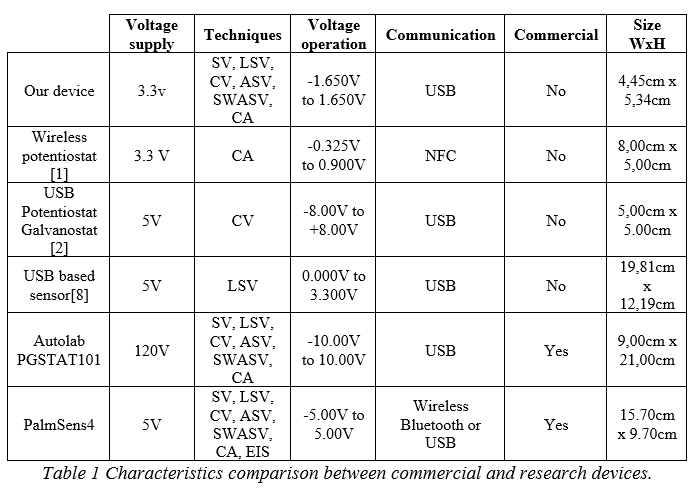(670d) A Low-Cost Muti-Technique Portable Electrochemical Device for Biosensors
AIChE Annual Meeting
2020
2020 Virtual AIChE Annual Meeting
Food, Pharmaceutical & Bioengineering Division
Cheaper, Better, Faster, Stronger - Enhancements to Established Sensing Techniques
Friday, November 20, 2020 - 8:30am to 8:45am
Later, the device has been continually evolving in the measurements required for the biosensors developed in our research group. Through the use of the developed platform on different projects on the group as a tool to make analysis, other electrochemical measurements were added over time, all using the same platform. At this moment, the device can do staircase voltammetry (SV), linear sweep voltammetry (LSV), cyclic voltammetry (CV), anodic stripping voltammetry (ASV), square-wave anodic stripping voltammetry (SWASV), and chronoamperometry (CA). Besides, we are working to adding more functionalities to the platform. Moreover, we are working on giving the device multiplexing functionalities and an auto range for current measurements on the next version. However, our portable electrochemical device needs a sensing element. So, we developed low-cost electrodes based on screen printing electrodes, such as used by [7]. Our electrodes were made using Printing Circuit Board (PCB) techniques. Briefly, using an FR4 substrate with a copper (Cu) layer of approximately 70µm, we create a three-electrode cell using wet chemical etching, then, we expose the Cu and evaporate a layer of gold over the electrode. Finally, a layer of protective solder mask is used to had a controlled exposition area for the sensor. After that, the electrodes are functionalized according to the experiment and could be used with the platform developed.
Our device is powered by 3.3v, weights about 20g, and its dimensions are 4,45 cms of width, 5,34 cms of length, and around 2 cms of height. It could measure currents from approximately 5 µA up to 10 mA. Also, the techniques of the device could use voltages from the range from -1.6v up to 1.6v. Additionally, the software shows the measured value each 60ms, and it is fully customizable for each procedure that it could do. This device is developed to work with a three-cell electrode designed built by our research group using PCB techniques. Those electrodes had a final coating layer of gold (Au), on which molecules can be functionalized. The use of functionalized electrodes with biological elements such as proteins, antibodies, or enzymes, gives the platform biosensing capabilities. About the device characteristics, Table 1 presents a comparison of our device against other reported on literature and also to commercial tools used in laboratories.
Finally, our device has implemented seven techniques which are common to electrochemical test, even though it could not achieve the range of the commercial tools, the range it had is suitable for biosensors. Due to the small voltage required to the reactions as presented on [9] where they use techniques like EIS and CV to detect different pathogens and shown voltages used for CV in the range of ± 0.700V. Also, authors of [10] present electrochemical biosensors for antioxidant analysis in food. In their review, there are DNA-based biosensors, enzyme-based biosensors, and others. Most of the biosensors reviewed use CV as a technique used to make the measurement.
References
[1] M. D. Steinberg, P. Kassal, I. Kereković, and I. M. Steinberg, “A wireless potentiostat for mobile chemical sensing and biosensing,†Talanta, vol. 143, pp. 178–183, 2015, doi: 10.1016/j.talanta.2015.05.028.
[2] T. Dobbelaere, “A USB-controlled potentiostat/galvanostat for thin-film battery characterization,†HardwareX, vol. 2, pp. 1–12, 2017, doi: 10.1016/j.ohx.2017.08.001.
[3] T. Luo, H. Wang, H. Song, and J. B. Christen, “CMOS potentiostat for chemical sensing applications,†Proc. IEEE Sensors, no. 262005, pp. 0–3, 2013, doi: 10.1109/ICSENS.2013.6688271.
[4] C. Y. Huang, H. T. Huang, and R. T. Yuan, “Design of a portable mini potentiostat for electrochemical biosensors,†Proc. 2017 IEEE 2nd Adv. Inf. Technol. Electron. Autom. Control Conf. IAEAC 2017, pp. 200–203, 2017, doi: 10.1109/IAEAC.2017.8054006.
[5] R. Pruna et al., “A low-cost and miniaturized potentiostat for sensing of biomolecular species such as TNF-α by electrochemical impedance spectroscopy,†Biosens. Bioelectron., vol. 100, no. July 2017, pp. 533–540, 2018, doi: 10.1016/j.bios.2017.09.049.
[6] O. J. F. Segura Crhistian C, “Miniaturization of Cyclic Voltammetry Electronic Systems for Remote Biosensing,†Int. J. Biosens. Bioelectron., 2017, doi: 10.15406/ijbsbe.2017.03.00068.
[7] S. Vineeth Raj, J. Stanley, and T. G. Satheeshbabu, “Fabrication of a Configurable Multi-Potentiostat for LOC Applications,†Mater. Today Proc., vol. 5, no. 8, pp. 16732–16739, 2018, doi: 10.1016/j.matpr.2018.06.038.
[8] S. Bukkawar, N. Sarwade, and M. Panse, “Polyaniline assisted USB based sensor for determination of benzene biomarker,†Sens. Bio-Sensing Res., vol. 22, no. January, p. 100260, 2019, doi: 10.1016/j.sbsr.2019.100260.
[9] E. Cesewski and B. N. Johnson, “Electrochemical biosensors for pathogen detection,†Biosens. Bioelectron., vol. 159, no. April, p. 112214, 2020, doi: 10.1016/j.bios.2020.112214.
[10] Y. Ye, J. Ji, Z. Sun, P. Shen, and X. Sun, “Recent advances in electrochemical biosensors for antioxidant analysis in foodstuff,†TrAC - Trends Anal. Chem., vol. 122, p. 115718, 2020, doi: 10.1016/j.trac.2019.115718.
